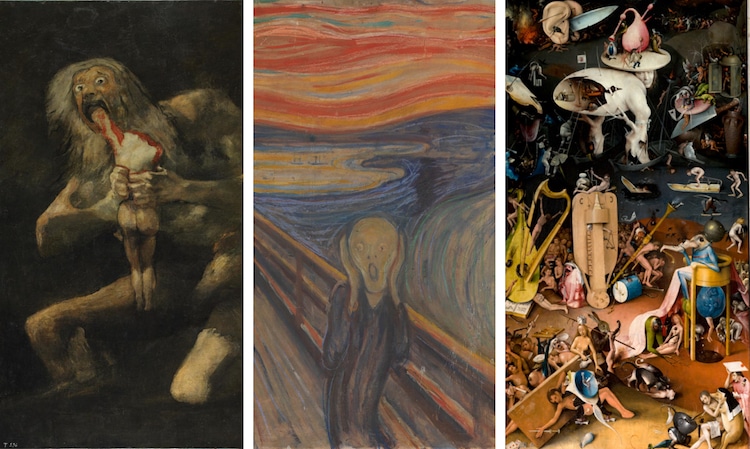Halloween is here! While tricks, treats, and other goodies offer a conventional way to celebrate the spookiest time of the year, we like to get creative while we get into the holiday spirit. So, we’ve conjured up a spell-binding selection of art history’s scariest masterpieces.
Listen beautiful relax classics on our Youtube channel.
Featuring symbolic skulls, smiling spiders, and one very famous Scream, this art collection is sure to dazzle art lovers and scare-seekers alike this Halloween—one hair-raising work of art at a time.
To celebrate Halloween with an art history twist, we’ve put together a spine-tingling selection of scary art.
A Spooky Still Life
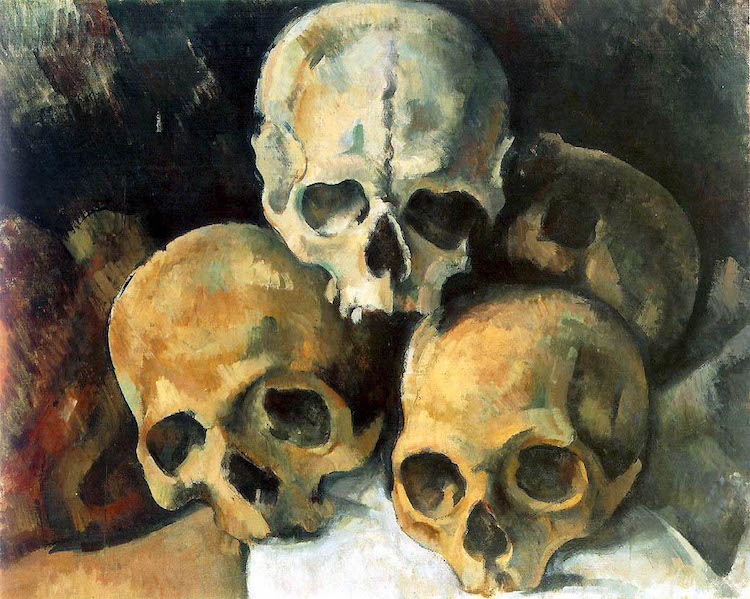
Paul Cézanne, “Pyramid of Skulls,” 1901 (Photo via Wikimedia Commons Public Domain)
Modern art master Paul Cézanne painted Pyramid of Skulls at the turn of the century. Featuring only a stack of human skulls as its subject, this piece offers an ominous alternative to the artist’s more traditional still life paintings of fruits and bottles.
While such eerie iconography was not typical of Post-Impressionism, artists had been incorporating skulls and other symbols of mortality into arrangements of objects since ancient times. Defined as memento mori, a Latin title that translates to “remember that you have to die,” this genre of painting focuses on the fleeting nature of life.
As he approached old age, Cézanne became increasingly fascinated by death. From 1898 until the end of his life in 1905, Cézanne painted several still lifes of skulls. While most of these depictions do not focus solely on the skeletal objects, Pyramid of Skulls places them at the forefront, forcing the viewer to confront them and, consequently, reflect upon death. “These bony visages all but assault the viewer,” art historian Françoise Cachin said, “displaying an assertiveness very much at odds with the usual reserve of domestic still life tableaux.”
A Mythological Monster
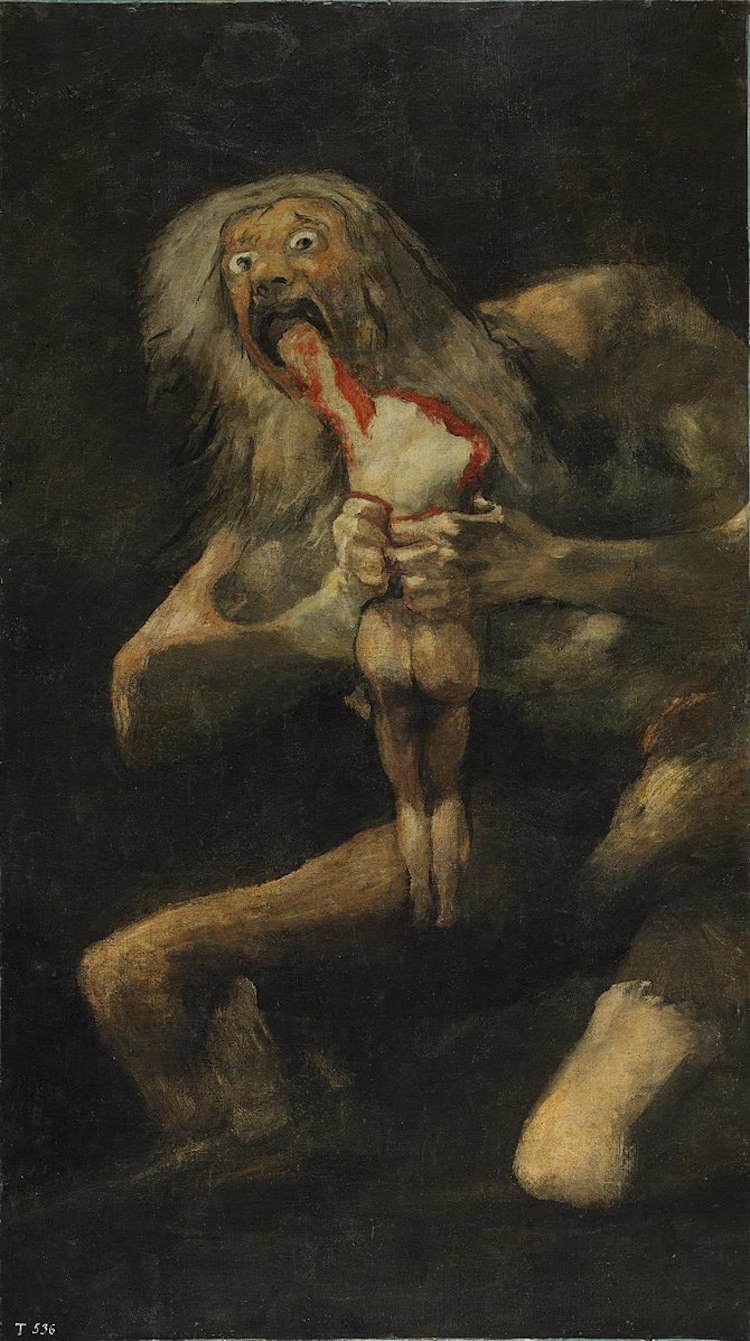
Francisco Goya, “Saturn Devouring His Son,” c. 1819-1823 (Photo: Prado Museum via Wikimedia Commons Public Domain)
Between 1819 and 1823, Spanish artist Francisco Goya created his Black Paintings, a series of 14 particularly haunting pieces. Among the most famous of these frightening works of art is Saturn Devouring His Son, a gruesome painting of a father feasting on his child.
According to Roman mythology, Saturn (Cronus in Greek folklore) was the leader of the Titans. Saturn overthrew his father, Caelus, in an effort to become ruler of the universe. Fearing his own offspring would do the same, he killed and consumed each child shortly after birth—an atrocity Goya opted to portray in this Black Painting.
Goya did not create this series for the public. In fact, they were intended to decorate his own home, with Saturn Devouring His Son hanging—where else?—in the dining room.
Mysterious Memories
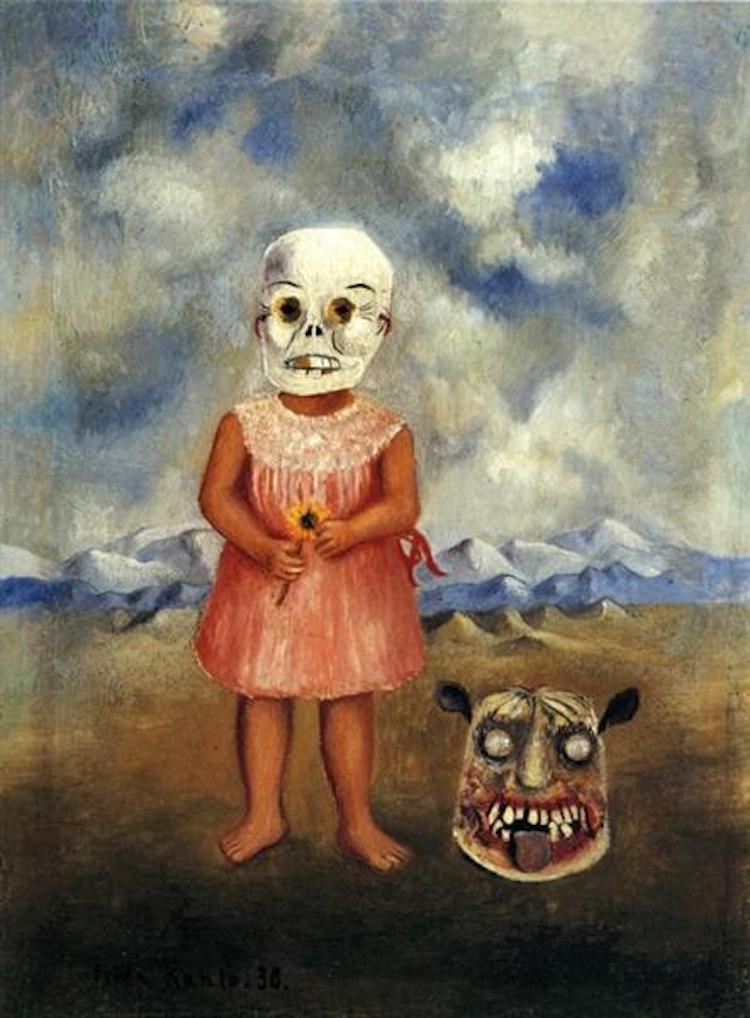
Frida Kahlo, “Girl with Death Mask (She Plays Alone)” 1938 (Photo: Wiki Art Fair Use)
Mexican painter Frida Kahlo is known for her collection of 55 self-portraits. While her most well-known works feature the artist as an adult, she also portrayed herself as a child in Girl with Death Mask (She Plays Alone).
This peculiar piece depicts a young girl standing before a barren landscape. In her hand, she holds a single yellow flower and, on her face, she wears a skull mask. Both of these props are characteristic of Día de los Muertos—or Day of the Dead— prompting the viewer to reflect upon themes related to death. Finally, a beastly mask rests at her feet, adding even more mystery to the chilling painting.
Girl with Death Mask (She Plays Alone) was painted in 1938—the year before her dramatic divorce from fellow artist Diego Rivera. Like many works created during this time, this piece was likely inspired by Kahlo’s feelings of isolation and loneliness. “I paint self-portraits because I am so often alone,” the artist famously said, “because I am the person I know best.”
A Creepy-Crawly Creature
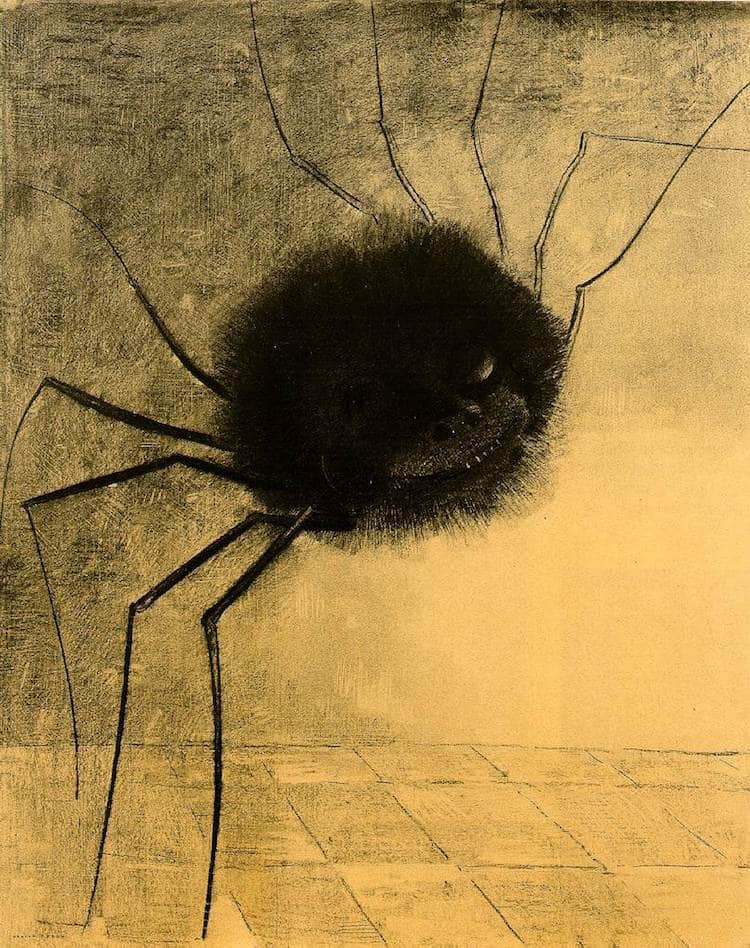
Odilon Redon, “The Smiling Spider,” 1887 (Photo via Wikimedia Commons Public Domain)
Listen beautiful relax classics on our Youtube channel.
In 1887, French Symbolist artist Odilon Redon created The Smiling Spider, a lithograph of an unusual arachnid with ten legs. Still, even with this extra set of limbs, the most peculiar thing about this spider is its unsettling grin, which the artist has delineated with a row of tiny teeth.
The Smiling Spider is one of many noirs, or “blacks” created by Redon between 1870 and 1890. Rendered in charcoal and as lithographs, these pieces illustrate the artist’s interest in the obscure and, most importantly, are characterized by darkness—both in color and subject matter.
“Black is the most essential color,” Redon said. “It conveys the very vitality of a being, his energy, his mind, something of his soul, the reflection of his sensitivity. One must respect black. Nothing prostitutes it. It does not please the eye and it awakens no sensuality. It is the agent of the mind far more than the most beautiful color of the palette or prism.”
A Scream Passing Through Nature

Edvard Munch, “The Scream,” 1891 (Photo: National Gallery of Norway via Wikimedia Commons Public Domain)
Expressionist artist Edvard Munch is renowned for his dark and dreary paintings and prints. From 1893 until 1910, he produced his most famous masterpiece: The Scream, a series of 4 works.
During this 17-year period, Munch recreated The Scream in crayon, tempera paint, and oil pastel. While the mediums vary from piece-to-piece, each one features the same subject matter: a mysterious figure standing on a bridge and holding his face as he screams.
While this scene appears dream-like, it was actually inspired by a real-life location—and a particularly frightening phenomenon. “One evening I was walking along a path, the city was on one side and the fjord below,” Munch wrote in his diary. “I felt tired and ill. I stopped and looked out over the fjord—the sun was setting, and the clouds turning blood red. I sensed a scream passing through nature; it seemed to me that I heard the scream. I painted this picture, painted the clouds as actual blood. The color shrieked. This became The Scream.”
A Bad Dream
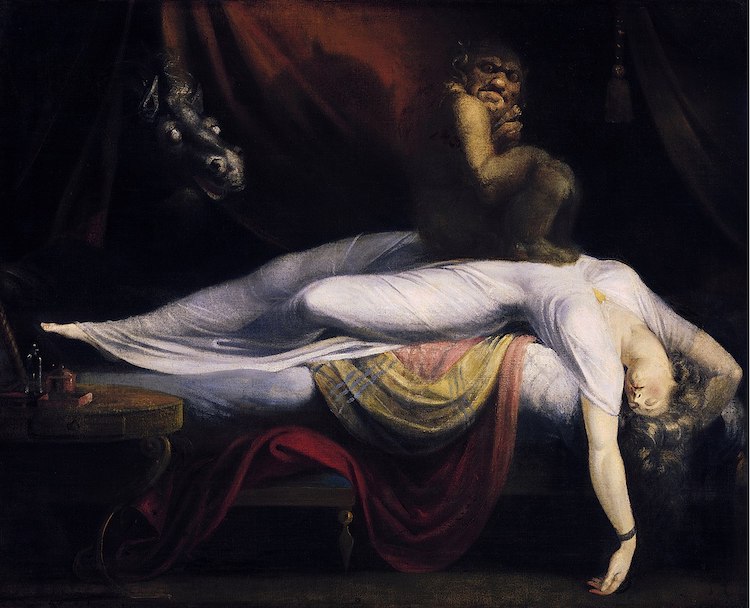
Henry Fuseli, “The Nightmare,” 1781 (Photo via Wikimedia Commons Public Domain)
Henry Fuseli was a leading figure of Romanticism, a 19th-century art movement defined by dreamy iconography. In his most famous (and aptly named) painting, The Nightmare, Fuseli delves into the scary side of the subconscious.
This spine-tingling work of art shows a sleeping woman with an incubus—a male demon that preys upon women as they sleep—perched on her body. A ghostly horse emerges from behind a red velvet curtain, forming the only perceivable part of the blackened background.
Most art historians believe that The Nightmare was inspired by German folktales. According to legend, men who slept alone were visited by horse specters, while lone women were possessed by demons or the devil. By incorporating both of these frightening figures in the composition, Fuseli visually represents the manifestation of a living nightmare.
A Surreal Scene
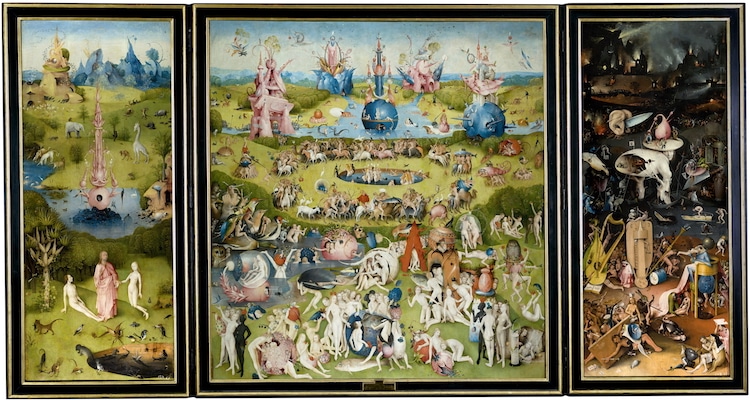
Hieronymus Bosch, “The Garden of Earthly Delights,” c. 1500-1505 (Photo: Prado Museum via Wikimedia Commons Public Domain)
Though he lived 500 years ago, Hieronymus Bosch remains the master of the macabre. The Early Netherlandish Renaissance artist is known for his surreal paintings of otherworldly settings—like the fantastic and frightening Garden of Earthly Delights.
While little is known about the origins of this this topsy-turvy triptych, it remains Bosch’s most resonant works of art. Featuring hybrid animals, make-believe machines, and everything in between, the chaotic painting strikes a perfect balance between eye-catching peculiarity and nightmare-inducing horrors—especially when observed in detail.
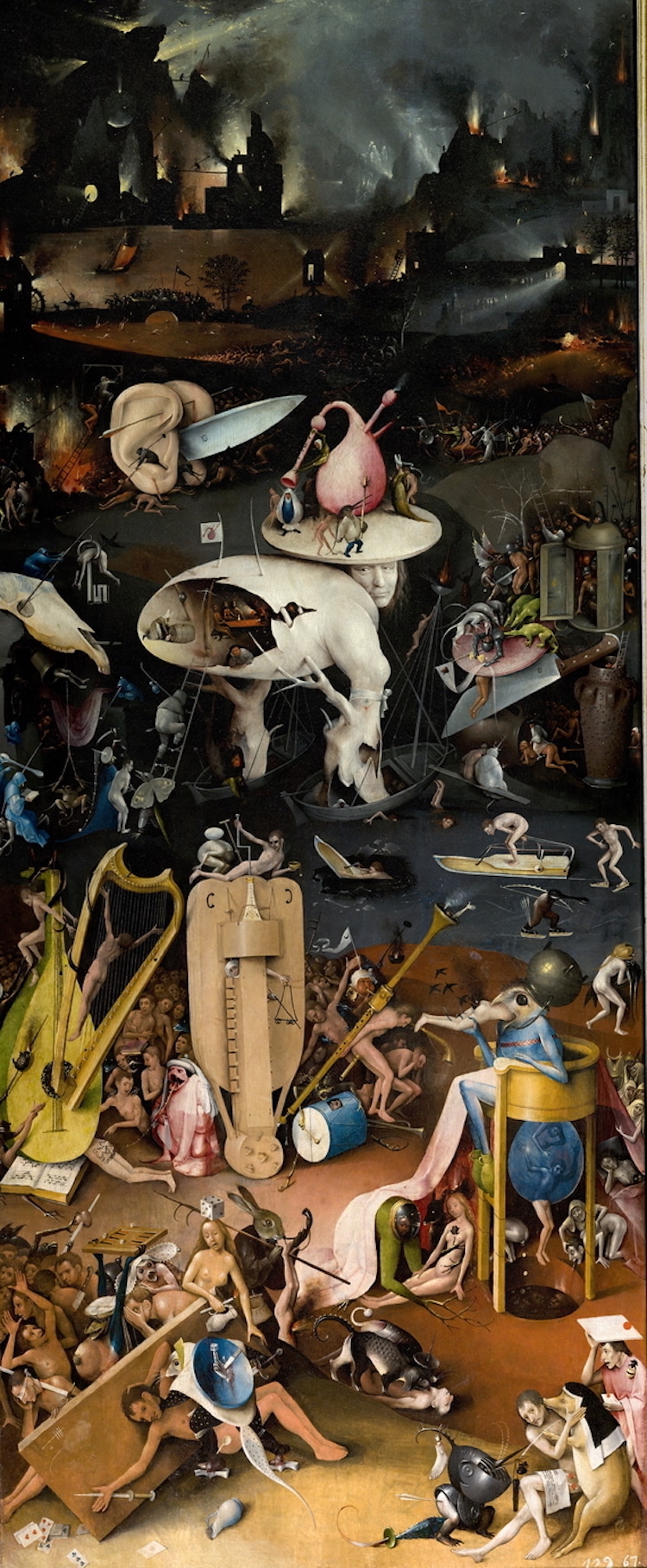
Hieronymus Bosch, “The Garden of Earthly Delights,” c. 1500-1505 (Detail)
A whimsical interpretation of the Bible’s Story of Creation, the Garden of Earthly Delights proves that any subject can be scary if given a surreal twist.
Related Articles:
13 Frighteningly Fun DIY Kits and Crafts for Halloween
30+ Artistic Halloween Makeup Ideas to Inspire Your Next Spooky Look
20+ Halloween Pumpkin Carving Ideas to Creatively Celebrate the Spookiest Time of Year
The post 7 of Art History’s Most Horrifying Masterpieces appeared first on My Modern Met.
Source: mymodernmet.com
